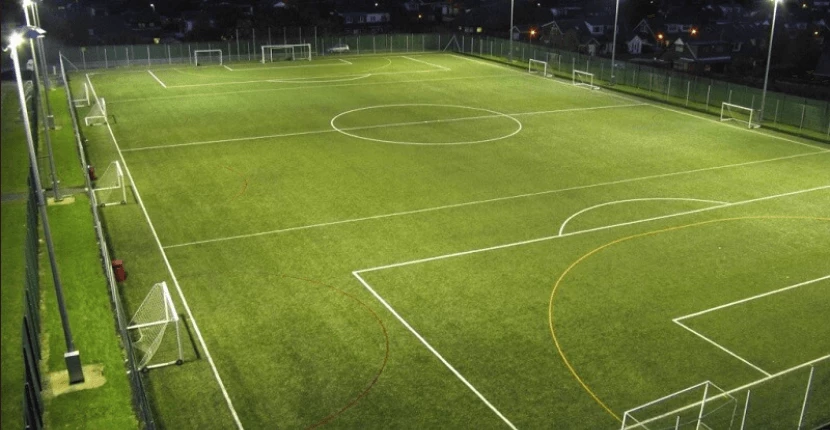
Football Pitch Markings
Enquire NowHigh-quality football pitch markings are essential for creating a safe, professional, and enjoyable playing surface.
Whether for schools, sports clubs, public parks, or training grounds, our thermoplastic football pitch markings provide a durable, weather-resistant, and slip-proof solution.
Designed to withstand heavy use and all weather conditions, our markings ensure clear, long-lasting lines that meet official standards. From 5-a-side and 7-a-side pitches to full-sized football fields, we offer custom designs tailored to your space.
With fast installation, low maintenance, and vibrant, non-fading colours, our football markings enhance gameplay and improve training experiences. Get in touch today for a free quote!
How much do Thermoplastic Football Pitch Lines Cost?
The average cost of thermoplastic football pitch lines is £750 - £1,200.
The cost of installing thermoplastic football line marking depends on the size of the pitch, design complexity, and surface preparation.
What are the Benefits of Thermoplastic Football Pitch Markings?
Thermoplastic football pitch markings are a superior alternative to traditional painted lines, offering long-lasting durability, enhanced safety, and low maintenance.
Whether for schools, sports clubs, public parks, or training facilities, thermoplastic markings provide a cost-effective, high-quality solution for creating professional football pitches.
Long-Lasting & Durable: Thermoplastic markings are designed to withstand heavy foot traffic, frequent matches, and harsh weather conditions. Unlike paint, they do not fade, crack, or wear away quickly, ensuring clear and defined lines for years.
Weather-Resistant: These markings are resistant to rain, UV exposure, and temperature fluctuations, making them perfect for all-weather play without the need for frequent touch-ups.
Slip-Resistant & Safe: The textured surface of thermoplastic provides better grip, reducing the risk of slips and falls, enhancing player safety during training sessions and matches.
Low Maintenance: Unlike painted lines that require frequent reapplication, thermoplastic football pitch markings retain their vibrant colour and structure for years with minimal upkeep, reducing long-term maintenance costs.
Quick & Efficient Installation: Thermoplastic markings can be installed within a few hours and are ready for play shortly after cooling, minimising downtime for schools and sports clubs.
Professional & Accurate Finish: Pre-cut thermoplastic ensures precise, regulation-standard pitch markings, making it ideal for competitive play and training sessions.
Cost-Effective Investment: While the initial cost may be higher than paint, the long-term savings on maintenance and repainting make thermoplastic a more economical choice for football pitch markings.
Where do we Install Thermoplastic Football Pitch Markings?
We provide professional thermoplastic football pitch markings for a wide range of locations, ensuring high-quality, durable, and regulation-standard markings for various playing surfaces. Our expert installation team works with:
Schools & Academies: We install football pitch markings for primary schools, secondary schools, and academies, creating engaging sports areas for PE lessons, training, and competitive matches.
Sports Clubs & Training Grounds: From grassroots football clubs to professional training facilities, our thermoplastic markings meet official standards, ensuring precision and longevity for high-performance play.
Public Parks & Recreational Grounds: We enhance community play areas and park football pitches with long-lasting markings, allowing for recreational games and organised matches.
Universities & Colleges: Higher education institutions benefit from permanent, weather-resistant football markings for both casual and competitive play.
Leisure Centres & Multi-Use Games Areas (MUGAs): Our thermoplastic football lines are ideal for multi-sport courts, allowing spaces to be used for various activities, including basketball, netball, and tennis.
Housing Developments & Private Estates: We work with housing associations, property developers, and private communities to install football pitch markings in shared spaces and recreational areas.
Holiday Parks & Activity Centres: Our durable markings are perfect for holiday resorts, outdoor activity centres, and adventure parks, providing a safe and engaging football area for visitors.
Whether you need a 5-a-side, 7-a-side, 9-a-side, or full-size football pitch, we can design and install bespoke thermoplastic markings to suit your space. Our markings are weatherproof, slip-resistant, and long-lasting, ensuring years of high-performance play.
Contact us today for a free quote and expert consultation!
